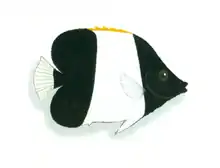Hemitaurichthys zoster
Hemitaurichthys zoster, commonly known as the brown-and-white butterflyfish, black pyramid butterflyfish, zoster butterflyfish, or brushtooth butterflyfish, is a marine ray-finned fish, a butterflyfish belonging to the family Chaetodontidae native to the Indian Ocean.
| Hemitaurichthys zoster | |
|---|---|
 | |
| Scientific classification | |
| Kingdom: | Animalia |
| Phylum: | Chordata |
| Class: | Actinopterygii |
| Order: | Perciformes |
| Family: | Chaetodontidae |
| Genus: | Hemitaurichthys |
| Species: | H. zoster |
| Binomial name | |
| Hemitaurichthys zoster (Bennett, 1831) | |
| Synonyms[2] | |
| |
Description
The black pyramid butterflyfish is a small-sized fish that can reach a maximum length of 18 cm.[3][4]
Its body is compressed laterally with a rounded body profile. The snout is somewhat stretched with a small terminal protractile mouth. The body is black, crossed in its center by a broad white trapezoid band with a yellow top, corresponding to the center of the dorsal fin. The caudal fin is white.[5]
Distribution & ecology
Hemitaurichthys zoster is widespread throughout tropical and subtropical waters of the Indian Ocean from the eastern coast of Africa to Java in Indonesia and from India to Mauritius.[1][3] It lives in large schools on outer reef slopes, from which it can sally into open water to feed on plankton.[6] The species is found at depths of 3–40 meters.[7][8]
Taxonomy and etymology
Hemitaurichthys zoster was first formally described as Chaetodon zoster in 1831 by the English zoologist Edward Turner Bennett (1797–1837) with the type locality given as Mauritius.[9] The specific name zoster means "belt" or "girdle" and is presumed to refer to the wide , white band in the middle of this fish's body.[10]
Conservation status
Hemitaurichthys zoster is a planktivore, and the species may be affected by climate-induced reductions in planktonic productivity. As there do not appear to be any specific current threats, it is listed as Least Concern (LC) by the IUCN.[1]
References
- Myers, R. & Pratchett, M. (2010). "Hemitaurichthys zoster". IUCN Red List of Threatened Species. 2010: e.T165719A6101058. doi:10.2305/IUCN.UK.2010-4.RLTS.T165719A6101058.en.
- Froese, Rainer and Pauly, Daniel, eds. (2019). "Hemitaurichthys zoster" in FishBase. December 2019 version.
- Lieske & Myers (2009). Coral reef fishes. Princeton University Press. ISBN 9780691089959.
- Heemstra, P.C. (1986). "Chaetodontidae". In M.M. Smith & P.C. Heemstra (eds.). Smiths' sea fishes. Berlin: Springer-Verlag. pp. 627–632.
- "Zoster butterflyfish". liveaquaria.com. Retrieved 23 November 2020.
- Anderson, C.; Hafiz, A. (1987). Common reef fishes of the Maldives. Part 1. Republic of Maldives: Novelty Press.
- Rudie Kuiter (2004). Chaetodontidae & Microcanthidae. Aquatic Photographics. ISBN 0953909735.
- Allen, G.R. & Erdmann, M.V. (2012). Reef fishes of the East Indies. Tropical Reef Research. I–III. Perth, Australia: University of Hawai'i Press.
- Eschmeyer, William N.; Fricke, Ron & van der Laan, Richard (eds.). "Chaetodon zoster". Catalog of Fishes. California Academy of Sciences. Retrieved 23 November 2020.
- Christopher Scharpf & Kenneth J. Lazara (21 July 2020). "Order ACANTHURIFORMES (part 1): Families LOBOTIDAE, POMACANTHIDAE, DREPANEIDAE and CHAETODONTIDAE". The ETYFish Project Fish Name Etymology Database. Christopher Scharpf and Kenneth J. Lazara. Retrieved 22 November 2020.
External links
- Photos of Hemitaurichthys zoster on Sealife Collection
